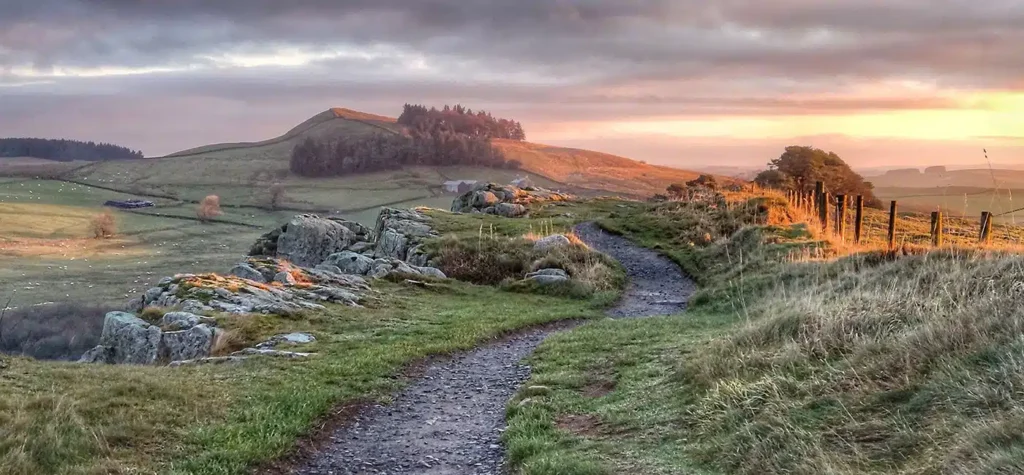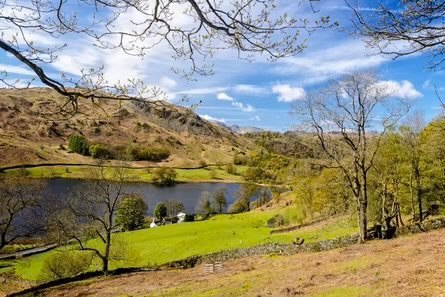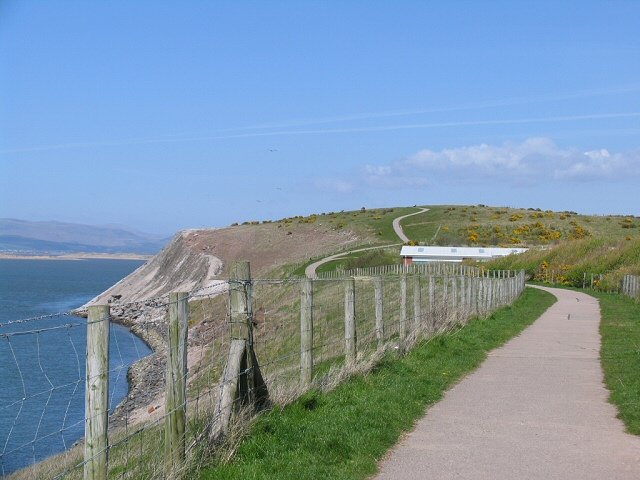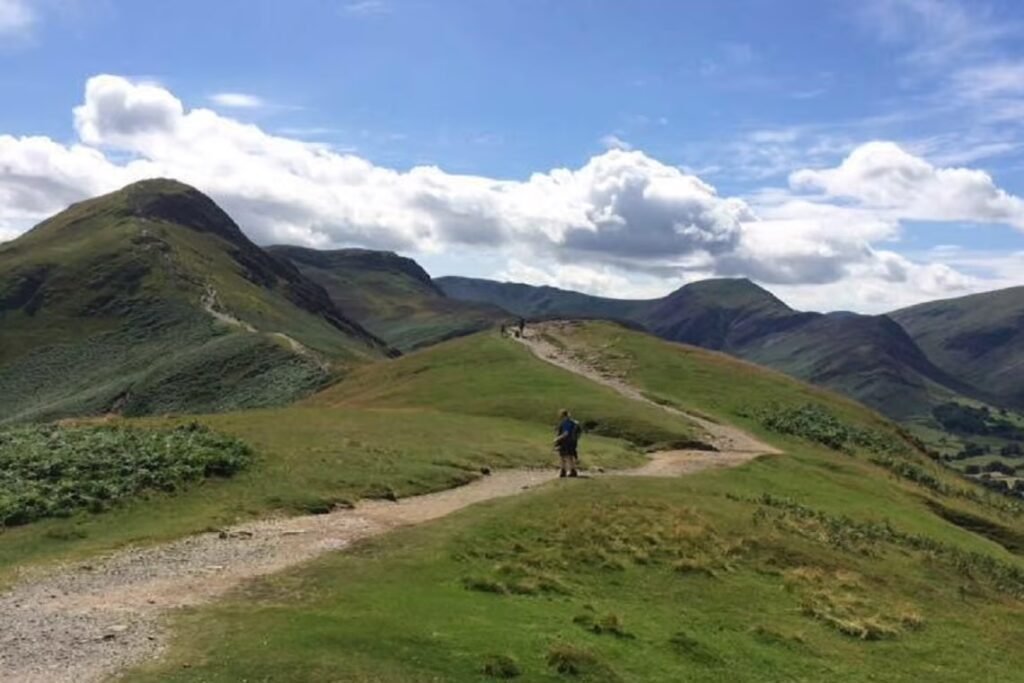
Key Points
- Research suggests Hadrian’s Wall Path is an 84-mile (135 km) National Trail from Wallsend to Bowness-on-Solway, following the Roman wall, with a history dating back to AD 122.
- It seems likely the path offers historical sites like Segedunum, Housesteads, and Vindolanda, with scenic views and moderate difficulty, taking 6–8 days to complete.
- The evidence leans toward it being ideal for history and nature enthusiasts, with practical tips for walkers including accommodation, transport, and what to pack.
- There is a minor controversy over trail length, with some sources suggesting 86 miles, but official data supports 84 miles.
Hadrian’s Wall Path: A Journey Through History and Nature
Hadrian’s Wall Path is a long-distance walking trail in northern England that follows the line of Hadrian’s Wall, a Roman fortification built in the 2nd century AD. Research suggests it’s an 84-mile (135 km) route from Wallsend in the east to Bowness-on-Solway in the west, offering a blend of history, scenery, and adventure. It’s perfect for those interested in Roman history, with key sites like Segedunum Roman Fort and Vindolanda, and for nature lovers, with views across Northumberland and the Solway Firth. The trail is moderate in difficulty, typically taking 6 to 8 days to complete, and is well-marked for walkers.
Why Walk It?
Walking Hadrian’s Wall Path lets you explore ancient Roman forts, milecastles, and turrets while enjoying diverse landscapes, from urban Newcastle to rural crags. It’s a chance to connect with history and nature, suitable for both seasoned hikers and beginners looking for a memorable adventure.
Key Highlights
- Start at Segedunum Roman Fort for a historical introduction.
- Visit Housesteads and Vindolanda for well-preserved Roman remains.
- Enjoy scenic views at Sycamore Gap and Steel Rigg, despite the tree’s felling in 2023.
- End at Bowness-on-Solway with wildlife spotting and a sense of achievement.
For more details, check out National Trails: Hadrian’s Wall Path or Visit Hadrian’s Wall.
A Comprehensive Exploration of Hadrian’s Wall Path
Hadrian’s Wall Path, launched as a National Trail in 2003, is an 84-mile (135 km) long-distance walking route in northern England, stretching from Wallsend, near Newcastle upon Tyne, to Bowness-on-Solway in Cumbria. This trail follows the line of Hadrian’s Wall, a UNESCO World Heritage Site built by the Romans in the 2nd century AD, offering walkers a unique blend of history, natural beauty, and cultural experiences. The guidebook “Hadrian’s Wall Path” by Cicerone Press, available at Cicerone Press, provides detailed maps and route descriptions, while resources like National Trails and Visit Hadrian’s Wall offer practical information for planning.
Background and Significance
Hadrian’s Wall was commissioned by Emperor Hadrian around AD 122, taking about six years to build, and served as the northern frontier of the Roman Empire, stretching approximately 73 miles (117 km) from the River Tyne to the Solway Firth. It was designed for defense against northern tribes, control of movement, and as a symbol of Roman power. The wall, with its forts, milecastles, and turrets, was manned by diverse auxiliary troops, leaving a rich archaeological legacy. Designated a UNESCO World Heritage Site in 1987, it’s one of Britain’s major tourist attractions, with the path providing access to its remains.
Some sources, like Mickledore Travel, suggest an 86-mile length, creating a minor controversy, but official data from National Trails supports 84 miles, likely due to variations in measurement or additional loops.
Detailed Route Description
The path is typically walked east to west, following the wall’s original construction direction, though west to east is recommended for better weather. It’s divided into five sections, each with historical and scenic highlights:
- Wallsend to Heddon-on-the-Wall (10 miles / 16 km): Starts at Segedunum Roman Fort, with a museum and reconstructed bath house, passing through Newcastle’s urban landscape to rural Heddon-on-the-Wall, where pubs offer rest stops.
- Heddon-on-the-Wall to Chollerford (15 miles / 24 km): Features Chesters Fort (notable for its bath house) and Housesteads Fort, with views from a ridge, entering more remote countryside.
- Chollerford to Birdoswald (16 miles / 26 km): Includes dramatic crags at Steel Rigg, Sycamore Gap (tree felled in 2023), and Vindolanda, known for Roman artifacts like writing tablets.
- Birdoswald to Carlisle (14 miles / 22 km): Passes Birdoswald Fort with views of the River Irthing, entering Carlisle, with its castle and cathedral rooted in Roman history.
- Carlisle to Bowness-on-Solway (19 miles / 30 km): Follows the wall to the Solway Firth, offering wildlife like seals and birds, ending at Bowness-on-Solway with a peaceful atmosphere.
The trail is well-marked with acorn symbols, as noted by Hillwalk Tours, making navigation straightforward, though some sections can be muddy, especially after rain.
History and Cultural Context
Hadrian’s Wall’s construction involved tens of thousands of workers, with stone in the east and turf in the west, and a vallum for added defense. It evolved from a military structure to an administrative one, with civilians settling nearby. Archaeological finds, like those at Vindolanda, reveal daily life, with writing tablets offering personal insights. The wall’s legacy includes its role in Roman border control, with forts like Housesteads and Chesters open to the public, as per Absolute Escapes.
Practical Tips for Walkers
Preparation is key for Hadrian’s Wall Path:
- Length and Duration: 84 miles, taking 6–8 days, with daily distances of 10–15 miles (16–24 km).
- Difficulty: Moderate, with steep ascents and descents, particularly around crags, suitable for most walkers with adequate fitness.
- Access and Parking: Car parks at key points like Housesteads and Vindolanda, with public transport options like trains to Newcastle and Carlisle, and buses like AD122.
- Accommodation: Options include hotels, B&Bs, hostels, and campsites, with popular stops like Twice Brewed Inn and Birdoswald campsite. Book in advance, especially in peak season (spring–autumn).
- When to Visit: Spring and autumn ideal for mild weather and wildlife; summer busy, winter quieter but shorter days.
- What to Bring: Sturdy boots, waterproof clothing, map/guidebook, water, snacks, first-aid kit, camera, binoculars for wildlife.
Safety tips include checking weather forecasts, letting someone know your plans, and being prepared for limited mobile coverage in remote areas, as advised by Matt Walk Wild.
Dining and Accommodation Options
After walking, refuel at pubs like the Kings Arms in Bowness-on-Solway or the Twice Brewed Inn near Housesteads, offering traditional meals. Accommodation ranges from luxury hotels in Carlisle to budget hostels and campsites, with booking advised during peak season.
Personal Experiences and Reviews
Walkers describe the path as “transformative,” praising its history and scenery, with highlights like Steel Rigg’s views and Vindolanda’s artifacts. Some note muddy sections but find them outweighed by rewards, recommending spring or autumn visits, as per Gallop Around The Globe and Your Time to Fly.
Modern-Day Relevance
In today’s fast-paced world, Hadrian’s Wall Path offers a chance to disconnect and reflect, aligning with conservation efforts. It’s ideal for history buffs, nature enthusiasts, and families, with facilities ensuring accessibility, as noted by The Guardian.
Conclusion
Hadrian’s Wall Path is a journey through time and landscape, celebrating Roman history and England’s natural beauty. Whether drawn by forts, views, or wildlife, it offers an enriching experience, with practical amenities ensuring a memorable visit. Pack your bags and explore this historic trail.
Supporting Resources
- National Trails: Hadrian’s Wall Path
- Visit Hadrian’s Wall
- Wikipedia: Hadrian’s Wall Path
- Cicerone Press: Hadrian’s Wall Path Guidebook
- Hillwalk Tours: Ultimate Guide to Hiking Hadrian’s Wall Path
- Gallop Around The Globe: 10 Things Nobody Tells You About Walking Hadrian’s Wall
- Your Time to Fly: My Midlife Walking Trip Across England on Hadrian’s Wall Path
- The Guardian: ‘I slept in ditches and dreamed of marauding raiders’: a wild walk on the Hadrian’s Wall path
- Absolute Escapes: Hiking Hadrian’s Wall Path: Your 2025 Essential Guide
- Matt Walk Wild: How to Walk Hadrian’s Wall Path: In-Depth Travel Guide


